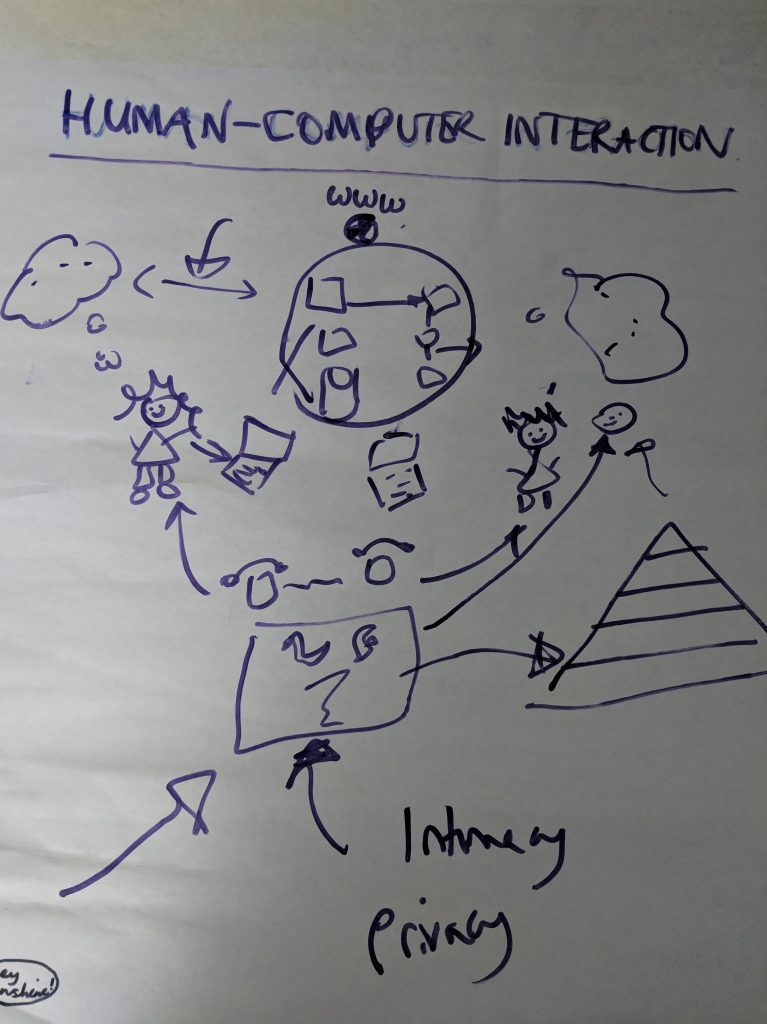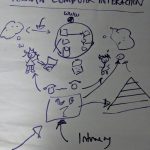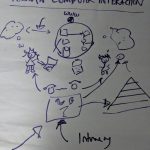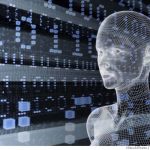[ 1) Introduction, 2) Dialogue or Conversation, 3) User or Used, 4) Codependency or Collaboration, 5) Productive or Experiential, 6) Conclusions]
[update 20/8/20: My guide to human-computer interaction is now available over on Udemy.]
The fig tree is pollinated only by the insect Blastophaga grossorun. The larva of the insect lives in the ovary of the fig tree, and there it gets its food. The tree and the insect are thus heavily interdependent: the tree cannot reproduce without the insect; the insect cannot eat without the tree; together, they constitute not only a viable but a productive and thriving partnership. This cooperative “living together in intimate association, or even close union, of two dissimilar organisms” is called symbiosis. (Licklider, 1960).
The above quotation is from JCR Licklider’s seminal paper Man-Computer Symbiosis (1960). I had to grit my teeth as he kept going on about man and men and computers. To distract myself from the onset of a patriarchal rage, I decided that I needed to know the precise definition of seminal. Google gave me seed of semen.
The original meaning of the word computer actually means a person who did calculations, like women in 1731 who ran a household and were advised to be clever with their husband’s wages, and whilst I am wondering about who is the tree and who the insect in this scenario of man-computer symbiosis, I am thinking that it really isn’t a good idea to aspire to have computers and people functioning as natural living organisms who cannot survive without each other. I love technology I really do, but the idea that I cannot function without it is, at the very least, disturbing.
We got a new boiler the other day complete with a smart thermostat. The smart thermostat uses an app now installed on everyone’s phone along with our locations activated to see if we are home or not and the thermostat uses the information and corrects the temperature accordingly. It will also build up patterns of our daily routine what time we get up, have a shower, take a bath, etc., so that it can be ready for us. But, only if we are home and have our phones charged. Thankfully, there are buttons on the thermostat if the WiFi goes down, apparently the earlier versions didn’t have them, and we can also log into a web browser to make changes to its routine.
Theoretically I should be thrilled, it is better than my Fitbit asking when my period is due so that it can tell me when my period is due – and since that blog, I have been given Google adverts for different sanitary products, I told you so! – or Google Nest which needs you to tell it how you want your house to run rather like my Fitbit. And, I do like data and patterns so I am interested in what it collects and what it does and if it is clever enough to respond to a cold snap or whatever.
But old habits die hard, so far we have got out an old room thermometer to check if the smart thermostat is measuring the temperature correctly as it seemed a bit high. It was right. (Just checked it, it says 25.8c the room thermometer says 22.8c quite a big difference) I guess I have just worked in computing too long and I have technology trust issues. If the Sonos is anything to go by when the WiFi goes down we are completely without music, well digital music at any rate. Last time, we got out the guitar and turned into the Vonn Trapps, I am not even joking. The alternative would be to keep other music formats and a player. But that idea doesn’t do a lot for me, I am more of a donor than a collector. I hate stuff filling up my space.
When I reader Licklider, I am reminded of ubiquitious computing rather than any other technology. I know I would rather my tech be ubiquitious than making me feel codependent on my mobile phone. All these apps for my heating, my music, my blogging, my Bikram, my electricity, my gas, it is slowly but surely turning into the precious and I feel like Gollum. I worry about my phone and can’t stand anyone touching it. Whereas ubicomp had the idea of one person, lots of computers interacting with, if I was doing it, the physiology of a person and making changes accordingly, rather than with the person’s mobile phone’s location, which strikes me as being a bit simplistic and not smart at all. (Just ‘cos you call it smart doesn’t make it smart.) And, then collecting and sharing over the Internet which causes us all to have the symptoms in the above codependent link – my phone does make me anxious and I try to please it all the time. I am forever staring at it and hoping it is doing ok, and I don’t like that feeling.
I have spent a lot of time writing about what social media can do for us, and how we can feel connected. But, in this scenario when it is not other people and it is an app, or sometimes it is other people via an app, if we are not in control, we become disconnected from ourselves and then we become addicted to the app or to the person. We give away our power and our data. The problem with these apps is that we have no control and we are barely a factor in the design. Our mobile phone is the factor in the design and it trains us to be codependent, addicted, anxious. Warmth after all is the bottom rung of Maslow’s hierarchy of needs and I am staring at my bloody phone hoping for the best. This is not symbiosis, this is codependency.
But back to Licklider and his seed of semen paper, a lot of what he was trying to imagine was probably about cooperation or collaboration of the kind I have blogged about before: a space of solutions to explore, with the computer doing the grunt work and the human doing the thinking. And, I believe it is possible to do that even with apps.
In a post, David Scott Brown, looks at what Licklider suggested in Man-Computer Symbiosis and what is possible today: shared processing, memory, better input-output, different languages, etc. And, I would add, in fields where the language is precise and limited, for example, Trading think about: buy, sell, high, low, and often over the phone so applications of AI are useful and will be able to do all sorts. All the data and conversations can be recorded and used and mined. It is extremely exciting, and memory and storage is it seems infinite which would make Licklider’s mind boggle.
As an undergraduate I had to learn sparce matrices, memory was something not to waste, it was expensive. In his paper, Licklider says:
The first thing to face is that we shall not store all the technical and scientific papers in computer memory. We may store the parts that can be summarized most succinctly-the quantitative parts and the reference citations-but not the whole. Books are among the most beautifully engineered, and human-engineered, components in existence, and they will continue to be functionally important within the context of man-computer symbiosis.
Imagine his face looking at the data centres all over the world storing memes and cat pictures and abusive tweets repeatedly without checking if they have already been saved, without indexing, without any sort of check on redundancy, an endless stream of drivvel. I am sure even Tim Berners-Lee wonders sometimes about the monster he has created.
And, books take so long to write, beautifully engineered they are, we lose ourselves in them and learn from them, they take us out of ourselves in the same way our phones do, but we are addicted to our phones and to our social media to that little hit of dopamine that social media gives us, which our books don’t always do. Books are work and we are passive whereas on our phones we feel active, but because our phones are controlling our homes and training us to be codependent and anxious and powerless, it is a vicious circle of more phones, fewer books.
In these times when I look at where we are going and I am not feeling good about it, like Licklider I turn to nature, as the best designs are in nature. I also look to the wisdom of yoga. So this is what I have:
When a bee gathers pollen, it also gathers a small amount of poison along with the pollen, both get transformed into nectar in the hive. The yogis say that when we learn to take negative situations and turn them into wisdom, it means we are progressing, and becoming skilful agents of the positive.
So, even though I worry about what happens when my whole life is literally on my phone and the world’s nature reserves are all full of data centres which contain every last terrible expression of humanity, and we are so disconnected from the nature around us that the oceans are filled with plastic, and many of us are in offices far away from the natural world staring into our bloody phones, and many of us do it to create technology. Surely we can create technology to change where we are. If we want a symbiosis we must make a human-planet one not a human-computer one. I don’t care what my Fitbit says I don’t want any technology in my ovaries thank you very much.
So, with that thought and the amazing technology I have at my fingertips today, I want to share an animated gif of my cat drinking from his water fountain. Licklider said:
Those years should be intellectually the most creative and exciting in the history of mankind
And, they are. I remain hopeful that we can collect enough data on ourselves to become self-aware enough to transform it into wisdom and create something better for all humanity and our planet. In the meantime I will be enjoying watching my cat have a drink of water and I am sure Licklider in 1960 would have been just as amazed too to see my cat drinking from the fountain on a phone more powerful technologically and psychologically than he ever could have imagined. It remains to be seen whether this is progress or not.
[Part 5]








11 comments